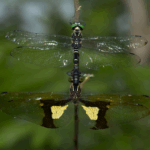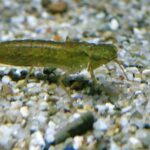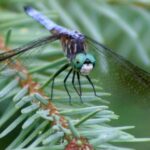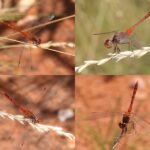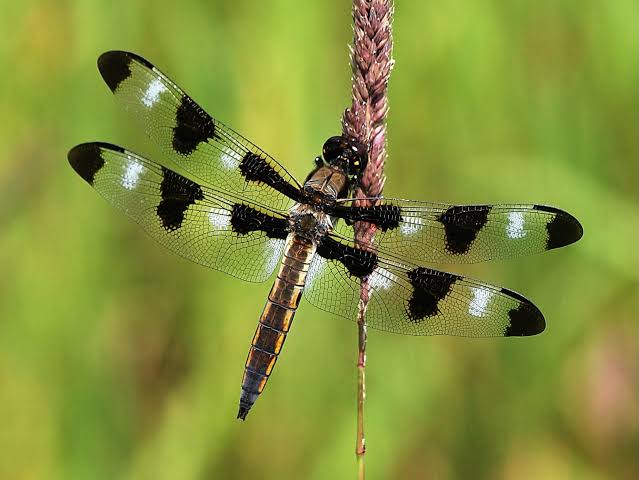
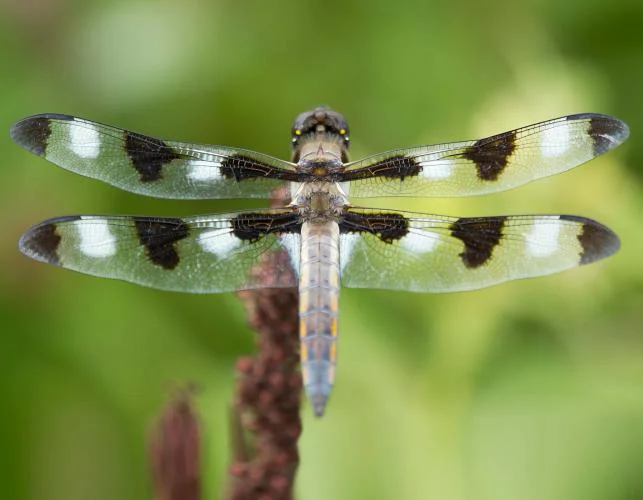
The twelve-spotted skimmer (Libellula pulchella) is a common North American skimmer dragonfly, found in southern Canada and in all 48 of the contiguous U.S. states.
It is a large species, at 50 mm (2.0 in) long. Each wing has three brown spots. In adult males, additional white spots form between the brown ones and at the bases of the hindwings; it is sometimes called the ten-spot skimmer for the number of these white spots.
Scientific Name:Libellula pulchella
Family:Libellulidae (skimmers) in the order Odonata (dragonflies and damselflies)
Description
The twelve-spotted skimmer has twelve dark brown wing spots. Males have eight additional spots that are white. Females lack the white spots.
Young males that have recently emerged as adults resemble females, with brown bodies with a yellow stripe along each side of the abdomen. As the males mature, a whitish (pruinose) coating develops on their bodies that can be rubbed off. As the male ages, the white coating may begin to look bluish.
An older name for this dragonfly was the ten-spot skimmer. Apparently, people were counting the middle spots, closest to the body, as a single spot that stretches across from wing to wing, yielding five spots for the front pair of wings and five for the hindwings.
General Description
The 12 spotted skimmer is a large showy dragonfly in the skimmer family; it looks even larger when flittering around the wetland because of the numerous spots placed along the length of the wing (6 spots on each side with black at the tip, a white spot nearest the tip is the Eight-spotted Skimmer). In mid-summer (July & August), they are very active and territorial often covering the whole wetland or lake shore on patrol and then returning back to the same area. This species is found statewide in ponds, lakes and wetlands with abundant emergent vegetation and oftentimes some open water. Like all adult dragonflies they eat smaller flying insects such as mosquitoes and flies, but will also take down damselflies and moths.
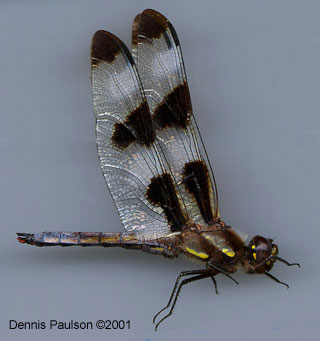
Phenology
Adults are most active in mid-summer, July & August, but can persist into September.
Diagnostic Characteristics
The 12 spotted skimmer has numerous spots alternating white and black along the length of the wing (6 spots on each side with black at the tip, 4 spots per wing and a white spot nearest the tip is the Eight-spotted Skimmer).
Twelve-spotted Skimmers are fast and agile. If given time to count, one would see a total of twelve black spots on all four wings of the male – three on each one. Between these black spots sit eight bright white spots that may even appear light blue. White smudges also appear next to the body. The female and immature males have the twelve brown-black spots, but not the white ones, so it is still acceptable to call them all twelve-spotted. Males have a powdery blue abdomen or ‘tail’. The female tail is mostly black with a long yellow stripe on each side. Adults feed on small flying insects.
Like other skimmers, the Twelve-spotted Skimmer is usually found near sources of water. Females lay eggs in ponds, lakes, or slow-moving streams and rivers where they hatch into naiads. The young naiads look more like crustaceans than dragonflies and spend this early life stage underwater. After feeding and growing, naiads eventually crawl out of the water and molt into winged adults.
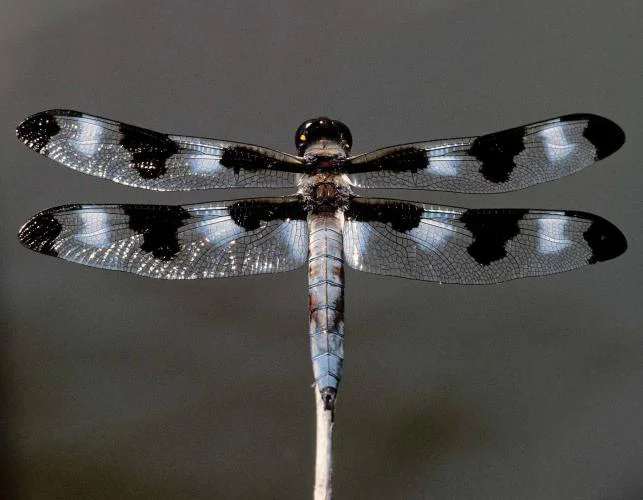
Notes from the field – Twelve-spotted Skimmer:One of the most dramatically patterneddragonflies, Twelve-spots are named for theirblack wing spots – 3 on each wing. However, it’sthe white-blue spots that make them such anawesome site. Although wide-spread and foundin most Northern VA watersheds, it’s unusual tosee more than a few at any one site. A littlemore picky in their habitat needs than many ofour skimmers, you’re unlikely to see them atyour typical storm-water detention pond. Theyprefer shallow, marshy wetlands, usually lessthen a foot, and often just a couple inches deep.The few times I’ve seen half a dozen of so atonce have been in wet meadows with shallowpools, or large, marshy puddles along mowedutility easements.
Look for them from late Julyto early September in open, sunny areas withshallow, vegetated water.The males are unlike any other dragonfly in ourarea, but the females can easily be confusedwith female Common Whitetails. Twelve-spotsare larger, with longer wings, but size can betricky in the field. The easiest way to tell the twofemales apart are the short, pale stripes on theedge of their abdomens – Twelve-spots havestraight abdominal stripes, while CommonWhitetails stripes are slanted.
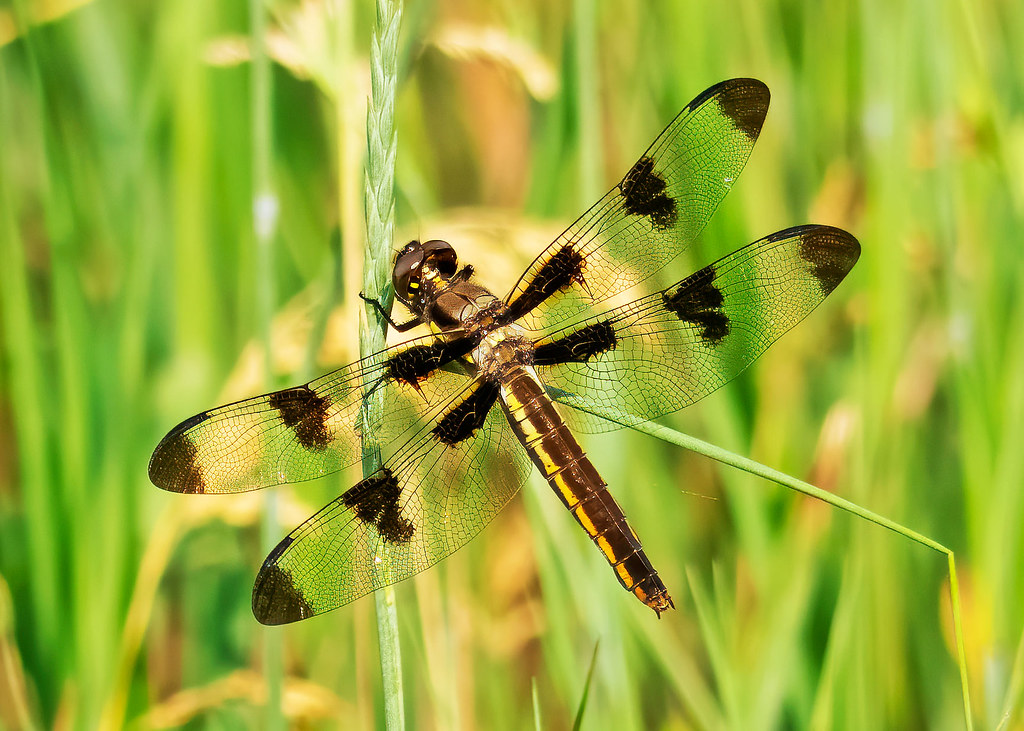
Naiad- This is a medium to large naiad with a length of 15/16 to 1 1/16 inches (24 to 27 mm). It is dark orange-brown in color, and the abdomen is rounded, giving it a short, stocky appearance known as the sprawler form. There is a small hook on the top of abdominal segments four through seven, and there is a thin, slightly curved, rear-facing spine on each side of abdominal segment eight and nine.
Adult- This is a fairly large dragonfly with a length of 2 to 2 ¼ inches (50 to 57 mm). Each wing is marked with three dark spots: one near the base where it attaches to the body, one in the center than nearly spans the width of the wing, and one at the tip. Females and immature males are brownish black. The side of the thorax is marked with two diagonal yellow stripes, and each side of the abdomen is lined with yellow. Mature males are brownish black, faintly marked with yellow, and become pruinose blue on the top of the abdomen. They may also develop a whitish patch on each wing to the outside of the spot next to the body.
Range:This species is found from British Columbia east to Nova Scotia, extending south through most of the U.S., from California east to Florida. It is absent from very dry areas. In Idaho, it occurs throughout most of the state except for the driest portions of the southwest.
Habitat:This dragonfly occurs near lakes, ponds and marshes, particularly those with exposed shorelines.
Adult Flight Season:Early June to late August
Diet: Naiad- Naiads feed on a wide variety of aquatic insects, such as mosquito larvae, other aquatic fly larvae, mayfly larvae, and freshwater shrimp. They will also eat small fish and tadpoles.
Adult- The dragonfly will eat almost any soft-bodied flying insect including mosquitoes, flies, butterflies, moths, mayflies, and flying ants or termites.
Ecology:Naiads live in the debris on the bottom of lakes, ponds, and marshes. They do not actively pursue prey but wait for it to pass by, a strategy which affords them protection from other predators. Naiads emerge as adults at night. Adults generally fly from early June through August. Hunting occurs from perches on twigs or rocks.
Reproduction:Males establish and defend territories, and are very aggressive towards members of their own species as well as other dragonflies. After males and females mate, the female flies singly, without the male attached, to lay her eggs. She does this by dipping the tip of her abdomen in the shallows of the body of water while hovering just above the water’s surface.


